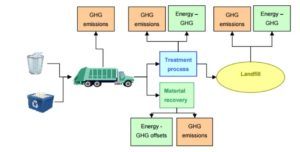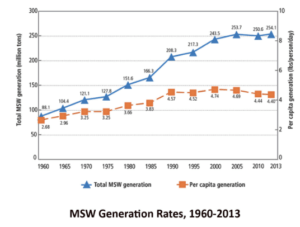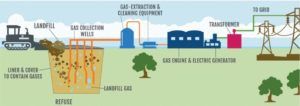“Waste”-ing our Planet Away

What happens to that Poland Spring bottle you just tossed in the trash? It’s not just piling up in a landfill – it’s causing global warming.
Climate Change and Waste
ADS is a solid waste management company that operates three distinct business lines: (a) collection: curbside collection services (b) landfills: transfer waste to landfills and recycling facilities and (c) recycling: process and sell recycled materials[1]. As the process diagram below indicates, each step in ADS’ business model contributes to climate change through the emissions of greenhouse gases (“GHG”). Each division’s profitability and fundamental business model will be impacted by systemic changes that look to mitigate the impact of climate change.
Collection Services
ADS generates revenue by collecting waste from the customer’s location through the use of its collection trucks. The majority of ADS’ trucks are diesel-fueled and so as they travel the city collecting waste the trucks emit Greenhouse gases[3]. In August 2016, federal regulators issued a three phased new greenhouse gas standard for waste trucks to comply with by 2027[4]. ADS’s profitability and cash flow projections will be impacted as they look to comply with this new regulation.
Landfill Background
ADS also generates revenue from operating municipal solid waste (“MSW”) disposal landfills. Municipal solid waste disposal in landfills is the third largest contributor accounting for approximately 20% to the total methane emissions (methane emissions are 25 times as effective as CO2 at trapping heat in the atmosphere and account for 11% of all emissions)[5]. American public behavior drives the amount of waste that is generated and deposited in landfills. The amount of MSW has been relatively constant since 2010 as public shifts habits towards increased recycling[6].
Landfill Regulation
In July 2016, the EPA issued new guidelines that regulate the amount of permittable methane emitted at landfills before the landfill is mandated to install a gas collection control system[7]. This new regulation impacts ADS since they will need to outlay additional capital in order to comply as well as improve their controls in order to accurately forecast when they will hit their limit at each landfill. According to the EPA’s Landfill Methane Outreach Program, “reducing methane emissions from municipal solid waste landfills is one of the best ways to achieve a near-term beneficial impact in mitigating global climate [8]”
Consumer Demand for Recycling
There has been a growing trend within the US about the importance of recycling. Many municipal governments are demanding waste management services to provide alternative waste collection methods, specifically recycling. However, increased public interest in recycling has caused many consumers to incorrectly recycle items. This has driven up ADS’ processing costs as ADS is forced to sort through the incorrect items[9]. Additionally, American consumers’ habits have changed to recycle more plastics than papers which has hurt ADS’ revenue stream as plastics are significantly lighter than paper[10].
Current Attempts to Address Challenges
Given the changing conditions in which they operate, Advanced Disposal has taken specific steps in trying to address each of these challenges.
- Given the changing regulatory environment, ADS has began to shift their vehicle mix over to trucks that run on compressed natural gas, which significantly reduces carbon emissions[11]. They currently have 16% of their fleet running on CNG with plans to increase over the coming years.
- Similar to the trucking landscape, ADS is already taking steps to address the challenge with landfills. Instead of letting the methane evaporate into the air, landfill gas collection systems collect some of that methane and then destroy it by combusting it in a flare or run it through a separate on-site facility to be converted into energy. This process is able to generate electricity which is delivered to the electrical grid to help power local homes and businesses. Currently 45% of ADS’ landfills have this type of system in place[12].
- Given the increased cost structure around recycling, ADS is working to increase their prices associated in order to maintain their ability to provide the same level of service[13].
Potential Improvements Going Forward
Although ADS has taken some steps to ensure their business model is prepared for the implications of climate change, there is more they can do.
- Continue to invest in landfill gas collection systems. They should commit that all of their landfills will be able to convert waste to energy by 2018. This is the most environmentally friendly way to address the methane emitting from the landfill.
- Invest profit dollars into R&D for alternate waste solutions.
- Incentivize municipalities to recycle in the proper way. ADS is currently bearing the cost of the additional sorting measures necessary when municipalities do not properly recycle. ADS should put a program in place that will offer municipalities a lower price should they properly recycle.
- Acquire or invest in a recycling business. This would allow ADS to experience economies of scale and potentially lower their prices to the consumer.
- Consider charging customers more for trash and providing discount for recycling services
(793 words)
[1] 2015 Annual Report; http://ir.advanceddisposal.com/investors/financial-information/annual-reports/default.aspx
[2] United Nations Environment Programme “Waste and Climate Change: Global Trends and Strategy Framework,” http://www.unep.or.jp/ietc/Publications/spc/Waste&ClimateChange/Waste&ClimateChange.pdf, accessed November 2016
[3] 2015 Annual Report; http://ir.advanceddisposal.com/investors/financial-information/annual-reports/default.aspx
[4] Clarissa Hawes, “EPA Tells Trucking Industry to Cut Greenhouse Gas Emissions, Raise Fuel Efficiency,” August 16, 2016, https://www.trucks.com/2016/08/16/epa-trucks-greenhouse-gas-standards/, accessed November 2016
[5] Environmental Protection Agency, “Inventory of U.S. Greenhouse Gas Emissions and Sinks,” April 15, 2016, https://www3.epa.gov/climatechange/Downloads/ghgemissions/US-GHG-Inventory-2016-Main-Text.pdf , accessed November 2016
[6] Environmental Protection Agency, “Advancing Sustainable Materials Management: Facts and Figures,” https://www.epa.gov/smm/advancing-sustainable-materials-management-facts-and-figures , accessed November 2016
[7] Erin Voegele, “EPA publishes updated standards, guidelines for MSW landfills”, July 18, 2016, http://biomassmagazine.com/articles/13495/epa-publishes-updated-standards-guidelines-for-msw-landfills, accessed November 2016
[8] Environmental Protection Agency, “Benefits of Landfill Gas Energy Projects,” https://www.epa.gov/lmop/benefits-landfill-gas-energy-projects, accessed November 2016
[9] Environmental Protection Agency Webinar Series, “The Changing Waste Stream,” https://www.epa.gov/sites/production/files/2015-09/documents/changng_wste_stream.pdf, accessed November 2016
[10] Claire Groden, “The American recycling business is a mess: Can Big Waste fix it?,” Fortune Magazine, http://fortune.com/2015/09/03/waste-management-recycling-business/
[11] 2015 Annual Report; http://ir.advanceddisposal.com/investors/financial-information/annual-reports/default.aspx
[12] Advanced Disposal Services, “LANDFILL GAS-TO-ENERGY,” http://www.advanceddisposal.com/media/62718/advanced-disposal-landfill-gas-to-energy-insert-122015.pdf, accessed November 2016
[13] 2015 Annual Report; http://ir.advanceddisposal.com/investors/financial-information/annual-reports/default.aspx







I like the idea of providing the right incentives for recycling the right way. Maybe one way to structure it would be through a rebate program where ADS sets a baseline rate of “correct recycling”, and passes on a percentage of the cost savings to municipalities that beat that rate.
I’m not so sure about ADS charging more for garbage and less for recycling.With falling commodity prices, recycling has been less and less profitable, so encouraging more recycling doesn’t make sense from a business perspective.
In fact, it might not even make sense from an environmental perspective. Couple quotes and link from an interesting NYT article on that below.
“In New York City, the net cost of recycling a ton of trash is now $300 more than it would cost to bury the trash instead. That adds up to millions of extra dollars per year — about half the budget of the parks department — that New Yorkers are spending for the privilege of recycling. That money could buy far more valuable benefits, including more significant reductions in greenhouse emissions.”
“Then why do so many public officials keep vowing to do more of it? Special-interest politics is one reason — pressure from green groups — but it’s also because recycling intuitively appeals to many voters: It makes people feel virtuous, especially affluent people who feel guilty about their enormous environmental footprint.”
http://www.nytimes.com/2015/10/04/opinion/sunday/the-reign-of-recycling.html?_r=0
Given that, I think ADS might (counterintuitively) have a greater positive impact on climate change by shrinking their exposure to recycling.
Thanks for this post! I was shocked to find out that the public interest in recycling has actually driven up recycling costs for ADS because consumers often incorrectly recycle items. I’m interested in discussing possible solutions for this – would a big public education campaign or better labeled recycling bins help? If companies like ADS already sort through waste for recyclables, perhaps the solution is reverting back to single-type trash cans and creating a PR campaign to educate consumers about how their waste will be recycled for them.
Thanks for the interesting, albeit rather depressing, read – I know we read about this in a prior case, but it’s still shocking to be reminded that Methane is 25X as effective at trapping heat in the atmosphere as CO2. I am curious about how one can educate folks on which products specifically are the greatest contributors to Methane emissions in landfills. 100% compliance with recycling initiatives would obviously be the ideal, but maybe people would think twice about throwing that X into the trash can if they knew how impactful it really was. Through some quick research, it looks as if methane gas created through the action of microorganisms – does that mean waste that is not organic is not the main driver of these emissions? Probably too simplistic an extrapolation, so this definitely warrants further research on my part – thank you for sparking my curiosity.